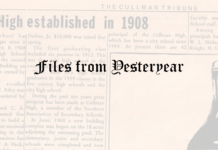
The Cullman Tribune is celebrating the Alabama Bicentennial (1819-2019) with statewide field reporting by Alabama Master Gardener/Botanical Artist Ben Johnson South. This year-long feature, “The 67-County Alabama Garden Party,” will spotlight different counties each week. Each county will get its own “quilt block,” along with a historical profile, and we’ll share a recipe specific to the area. At the end of the year, all 67 counties will be put in a book to commemorate the Bicentennial.
Winston County
Winston County is what Alabama started out to be: a place of jaw-dropping, natural beauty and fresh opportunity where good-natured folks value both self-reliance and neighborly kindness. Even 200 years later, this thickly forested, northwestern part of Alabama hill country is an antidote to the bland sameness of 21st century so-called progress.
Winston County has internet access, modern job opportunities and some locals believe–too many motorized watercraft on Smith Lake. Still, it proudly protects the land and the history of the bold pioneers. In many parts of the county, the moment you step out of the vehicle that transported you here, you are transported to pastoral and wooded territory much as it was in 1850 when the place, first called Hancock County, was established by the Alabama Legislature.
Hancock County was named for John Hancock, signer of the Declaration of Independence known for his patriotism and penmanship. The name changed to Winston County in 1858 to honor the first, native-born governor of Alabama, John Anthony Winston.
Yesterday, I was back in Winston County in Houston, Alabama to savor the famous breakfast at Chef Troy’s top-notch but far-from-fancy-schmancy café, Talk of The Town. Also, I traveled there with friends to tour the historically preserved “log jail,” the oldest in the state and one of the two oldest in the nation.
Our guide was one of Winston County’s most enthusiastic and tireless cheerleaders, Betty Denton, a friend who grew up playing in the Bankhead Forest like children in a storybook. Her dad came to this part of Alabama in the 1930s with the CCC (Civilian Conservation Corps) and that ultimately led to him becoming a forester in the USFS (United States Forest Service). I’m pretty certain Betty knew Little Red Riding Hood, Hansel, Gretel and Goldilocks. This beautiful forest does indeed feel fairytale magical and is richly laden with legends and stories.
Betty and my new friend, Chef Troy, took different routes to settle in Winston County, but they remain here for the same reason. Betty lived in this part of Alabama from birth to her Haleyville High School graduation, then left for college, career, marriage, child-rearing years, and she returned because this green haven always had her heart.
Chef Troy was a Californian. Statistically, it takes 8.5 years to adopt Alabama traits. He has lived here years longer than that and has contributed mightily to Houston and the county. Chef Troy is not just an Alabamian, he is a Winston Countian, which is kind of like Alabamian-on-steroids.
Both residents proudly call Winston County home because it’s a beautiful, peaceful, joyful, VERY ALABAMA place to live, work, play, be left alone when wants to be introspective and be happily amongst neighbors when that is desired or needed.
When I first imagined this Bicentennial exploration of how and where PLANTS + PEOPLE have intersected and do intersect across the state, the 67-County, Alabama Garden Party, I began by designing an icon, or “quilt block,” unique for each of the 67 counties. Some were predictable, perhaps cliché’: peaches for Chilton County, azaleas for Mobile County, sea oats for Baldwin County, a mockingbird eating berries in Monroe County. My project is celebratory, and I wanted the plant-centric quilt to have symbols that were positive and pleasurable.
The “quilt block” I designed for Winston County is an image of the unembellished, unvarnished “log jail” in Houston. There are many other pretty and even glorious plant images in Winston County: beautiful gardens, grand forests and charming thickets, lakeside reeds and rushes, a hanging basket of flowers on almost every porch, but the historically preserved “log jail” originally built in 1868 positively demonstrates the take-action character of this county to protect the law-abiding and address the law-breaking.
The Historic Houston Jail is one of the oldest surviving civic buildings in north Alabama. It was constructed of hand-hewn, hardwood logs from the nearby forest. The logs were covered on the inside by boards of native timber more than t2 inches thick which were sawn in Winston County at the water-powered Partridge Sawmill on the Sipsey River. Note the unique “rooster tail” roof design created with wooden shingles and how the building was wisely positioned to resist strong winds.
This 19th century Winston County correctional facility did not coddle the jailed. As my friend, Betty, toured my friends and me around the modest, nearly windowless structure, she brought the senses alive: the food for prisoners would be minimal, soup made of whatever was in season or some prisoner’s family had “put up” for the winter. There was no plumbing, just a hole in the wall that every little boy who tours mimes “peeing out of.” The sound would be of whistling wind through the two small, iron-clad windows. The rough log walls had become maximum security with hundreds of horseshoe nails driven into the logs. The nails, made by a local blacksmith, are placed closely to discourage any jail breaks such as might occur by sawing through the timbers.
Winston County is a good place to talk about how food plants could be used more in Alabama jails and prisons. For me, a surprising advocate of “prison food reform” nationally is the blonde television “bombshell,” Pamela Anderson, more famous for her bathing suits on “Baywatch” than cellblock culinary counsel. I encourage you to do an internet search for “Pamela Anderson prison food.” It will give you “food for thought.”
The actress/activist promotes nutrition research which seems to support that providing prisoners “meatless, vegan meals” could reduce their aggression and improve their health. I would also suggest Alabama prisoners would be easier and less expensively managed if coffee and caffeinated colas were eliminated from our jails and prisons and replaced with tap water.
Alabama voters and lawmakers are again actively brainstorming how to humanely, effectively, sensibly manage our over-crowded prisons and jails. One idea is to invite prison reform activist Pamela Anderson as a celebrity guest to tour the historic Winston County “log jail” and then join a town hall “ideas summit” with tasty, locally grown vittles at Chef Troy’s café. I’m betting we could get at least half of the generous-spirited folks in this part of the state to join the conversation.
While you’re enjoying the historic preservation and natural beauty on your 67-County, Alabama Garden Party tour, here are other positive and pleasurable ways PLANTS + PEOPLE come together in Winston County:
*WINSTON COUNTY FARMERS’ MARKET- Rocky Ravine Park, Highway 195, near 20th Ave., Haleyville, AL 35565; Tuesdays, Thursdays and Saturdays, 6 a.m.-noon, June-October
*WINSTON COUNTY FARMSTAND/U-PICK- Brannon Farms, 20302 County Road 41, Addison, AL 35540; April-October, 8 a.m.-9 p.m.; branfarms@yahoo.com; tomatoes, cucumbers, squash, watermelon, blueberries, sweet corn, muscadines, pumpkins
*CHEF TROY’S TALK OF THE TOWN RESTAURANT- 4815 County Road 63, Houston, AL 35572, 205-489-1700 or 205-489-9318; Sunday-Wednesday, 6:30 a.m.-2 p.m. and Thursday-Saturday, 6:30 a.m.-9 p.m.; Chef Troy salutes local growers and he caters meals across north Alabama; his Smoked Chicken Chipotle Corn Chowder, which makes 5 gallons, is a HUGE hit in the popular “Alabama Back Road Restaurant Recipes” cookbook, but few folks leave his café without a slice of his belly-delighting, Peanut Butter Pie. Here’s the simple instructions the big-hearted, Alabama food star shared with us: PEANUT BUTTER PIE—Ingredients: 1 cup peanut butter, 1 cup condensed milk, 1 (8-ounce) tub of Cool Whip, 1 graham cracker pie crust—Directions: Combine peanut butter and condensed milk in a mixing bowl. Fold in Cool Whip. Pour into pie shell and refrigerate until ready to serve.
*BANKHEAD NATIONAL FOREST- Covering 181,230 acres and one of Alabama’s four national forests, Bankhead is home to the state’s only National Wild and Scenic River, the Sipsey Fork. Even before European settlers came here, the forest was known as “The Land of a Thousand Waterfalls.” Within the forest lies the Sipsey Wilderness. Native American relics abound, including petroglyphs. Near the town of Double Springs, this is a hiker’s, birder’s, picnicker’s, landscape artist’s wonderland.
*NATURAL BRIDGE- A privately-owned park with a sandstone and iron ore, naturally-formed bridge 60 feet high and 148 feet long. Here you’ll find 27 varieties of ferns and a variety of hemlock that dates back to the Ice Age. This natural formation is thought to be 200 million years old
*WINSTON COUNTY PLANT ADVICE/EDUCATION- The Alabama Cooperative Extension System local office is at 24714 Highway 195, Room 1, Double Springs, AL 35553, 205-489-5376
*CHURCH OF THE FOREST- It is on the North Alabama Hallelujah Trail, which highlights 32 churches that are each more than 100 years old. This spiritual gathering place amid the dense trees was originally called Grayson and owes its existence largely to the Clancy Lumber Company. 51 County Road 94, Houston, AL 35572, 205-272-0034
*”THE OLD RUGGED CROSS MADE THE DIFFERENCE”- This classic Southern Gospel song was made famous by The Speer Family who farmed near Double Springs; the award-winning group began in the 1920s and was one of the first in Southern Gospel to include women singers.
*”GREEN ACRES” TELEVISION STAR FROM ADDISON- Pat Buttram, the comic sidekick of singing cowboy star, Gene Autry, was born in Winston County near Addison June 19, 1915. He starred in more than 40 movies and 100 episodes of “The Gene Autry Show” on television. He is most remembered for the playing the role of Mr. Eustace Charleston Haney, opposite Eddie Albert and Eva Gabor, on the 1960s television comedy, “Green Acres.” When this son of a Winston County preacher man was honored by a star on the “Alabama Stars of Fame” sidewalk in front of the Alabama Theatre in downtown Birmingham, he joked, “Dad said if I continued in show business, I’d end up on the streets.”
*”THE FREE STATE OF WINSTON” WAS PROCLAIMED IN JEST- …by “Uncle Dick Payne” when the citizens met July 4, 1861 at Looney’s Tavern to debate the locals’ role in the looming American Civil War; someone suggested that if states could secede from the United States then counties could secede from states. Uncle Dick, as everyone knew him, a fur skinner known for his sarcastic wit, quipped “Oh, Oh, Winston secede! The Free State of Winston!” The term became legend and remains misquoted today. Uncle Dick joined the Confederates; he was so shrewd he managed to finagle a Confederate Bank charter and printed his own $10 notes on brown paper which read “Dick Payne the banker will pay the bearer $10.”
*PLANTING AN IDEA- Using the Historic Houston Jail as a centerpiece, Winston County could host a nationally televised “town hall” discussion on prison reform including job training in such things as hydroponic gardening for a plant-based diet which could train the jailed population for self-reliance upon release.
Y’ALL COME to this naturally green oasis on your 67-County, Alabama Garden Party tour. You won’t have to be handcuffed to extend your visit.
Many thanks to Betty Denton for her informative and entertaining tour of the Historic Houston Log Jail and to Chef Troy for his legendary and delicious hospitality.
Winston County, Feeding a Crowd – Hearty, Healthy and Budget-Conscious White Chicken and Black Bean Chili (8 – 10 servings)
When the weather cools off, many of us love a traditional beefy, tomato-based chili. However, for years, this white chicken and black bean chili this has been my “go-to” chili for feeding a crowd. It’s healthy, but hearty, and doesn’t break the bank when you have a bunch of hungry people. It can be made a day in advance, refrigerated, and simmered on the stove or in the crock pot before serving. As with many dishes, the flavors may actually be better the next day. It also freezes well and is a comfort to have on hand, so while the kitchen is already in use (as in messed up), double the recipe to have one to share or freeze for yourself. Serve hot with fresh garnishes such as green onions, lettuce, tomato, avocado, lime juice, cilantro or olives plus dairy garnishes like shredded cheese and sour cream. You can also serve with cornbread, grilled cheese sandwiches or just crackers or corn chips and enjoy!
Ingredients:
- Olive or vegetable oil for sautéing
- 2 large sweet or yellow onions – medium chopped
- ~ 3 tbsp. diced jalapeno – more or less to taste and ~ 3 tbsp. minced garlic
- 1 large can black beans – rinsed and drained (Cook beans from dried to be even more budget-friendly.)
- 2 packages white chicken chili seasoning mix – or your own chili seasonings if you don’t like these mixes – They provide plenty of salt so don’t add any extra if you use them.
- Chopped chicken (large chop) from 2 whole cooked chickens (rotisserie, roasted or any way that you want to get that much cooked dark and white chicken meat)
- 1 – 2 large cartons of chicken broth – Start with one and add second as needed for consistency after you add the corn “flour.”
- “Corn flour” – ~1/2 cup corn meal or masa and/or lightly crushed tortilla or corn chips
- Additional seasonings: black and/or white pepper, extra chili powder, smoked paprika, cumin, red pepper flakes, salt if needed – Taste and season lightly as you go and in the last ~ 30 minutes.
- Garnishes: shredded cheese, sour cream, chopped lettuce and tomatoes, avocado, lime, black olives, jalapenos, minced onions, cilantro, salsa, corn chips – whatever you like
Instructions:
- In a large Dutch oven, sauté the onion in oil until starting to soften. Add the diced jalapeno and garlic for about another minute. Add drained beans, the seasoning mix and a little of the chicken broth. Stir and simmer for a few minutes to get the seasoning distributed.
- Add more broth and the chopped chicken and stir to get flavors distributed. Add some corn meal or masa now, or wait until later for just corn chips. The more meal or masa you add, the more broth you need as it continues to cook. After adding the chicken, minimize vigorous stirring since it can leave the chicken too stringy – fold or stir gently from now on.
- Cover and simmer on low for a couple of hours, stirring and adjusting liquid (chicken broth) occasionally. Before this two-hour simmering, you can stop and refrigerate overnight and simmer on the stove top or in a crock pot on low for several hours the next day. The flavors are actually better the next day.
- Taste as you go – adjusting broth for consistency and seasonings to taste.
- Stir in crushed corn chips about 30 minutes before serving for them to absorb any additional liquid.
- Serve with garnishes and cornbread, grilled cheese sandwiches or just crackers or corn chips for a hot, hearty and healthy meal that is also very budget-friendly for feeding a crowd.
Also, check out Alabama Bicentennial: 200 ways to save Alabama for the next 200 years.
Copyright 2019 Humble Roots, LLC. All Rights Reserved.
























